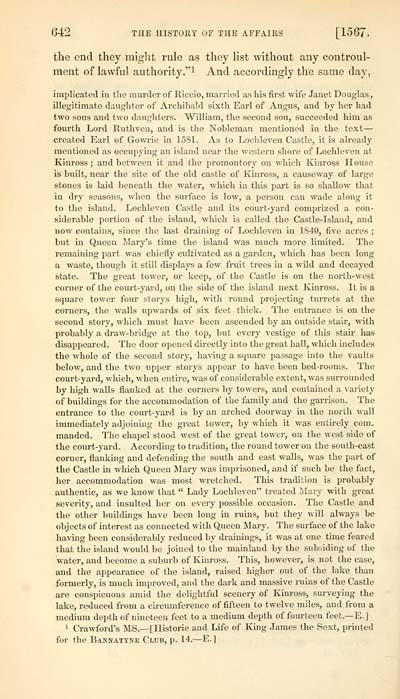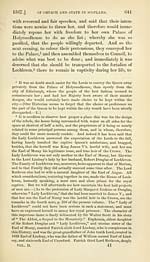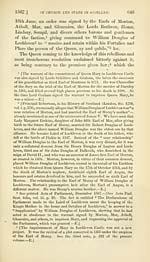Spottiswoode Society > History of the affairs of the Church and State of Scotland from the beginning of the reformation to the year 1568 > Volume 2
(666) Page 642
Download files
Complete book:
Individual page:
Thumbnail gallery: Grid view | List view

642 THE HISTORY OF THE AFFAIRS [1567.
the end they might rule as they Hst without any controul-
ment of lawful authority"! And accordingly the same day,
implicated in the murder of Riccio, married as his fu'st wife Janet Douglas,
illegitimate daughter of Archibald sixth Earl of Angus, and by her had
two sons and two daughters. William, the second son, succeeded him as
foui-th Lord Ruthven, and is the Nobleman mentioned in the text —
created Earl of Gowrie in 1581. As to Lochleven Castle, it is already
mentioned as occupying an island near the western shore of Lochleven at
Kinross; and between it and the promontory on which Kinross House
is built, near the site of the old castle of Kinross, a causeway of large
stones is laid beneath the water, which in this part is so shallow that
in dry seasons, when the surface is low, a person can wade along it
to the island. Lochleven Castle and its court-yard comprized a con-
siderable portion of the island, which is called the Castle-Island, and
now contains, since the last draining of Lochleven in 1840, five acres ;
but in Queen Mary's time the island was much more limited. The
remainuig part was chiefly cultivated as a garden, which has been long
a waste, though it still displays a few fruit trees in a wild and decayed
state. The great towei-, or keep, of the Castle is on the north-west
corner of the court-yard, on the side of the island next Kinross. It is a
square tower four storys high, with round projecting tiirrets at the
corners, the walls upwards of six feet thick. The entrance is on the
second story, which must have been ascended by an outside stair, with
probably a draw-bridge at the top, but every vestige of this staii" has
disappeared. The door opened directly into the great hall, which includes
the whole of the second story, having a square passage into the vaults
below, and the two upper storys appear to have been bed-rooms. The
court-yard, which, when entire, was of considerable extent, was surrounded
by high walls flanked at the corners by towers, and contained a variety
of buildings for the accommodation of the family and the garrison. The
entrance to the court-yard is by an arched doorway in the north wall
immediately adjoining the great tower, by which it was entirely com.
manded. The chapel stood west of the great tower, on the west side of
the court-yard. According to tradition, the round tower on the south-east
corner, flankmg and defending the south and east v>'aUs, was the part of
the Castle in which Queen Mary was imprisoned, and if such be the fact,
her accommodation was most wretched. This tradition is probably
authentic, as we know that " Lady Lochleven" treated ^tary with great
severity, and insulted her on every possible occasion. The Castle and
the other buildings have been long in ruins, but they will always be
objects of interest as connected with Queen INIary. The surface of the lake
havmg been considerably reduced by drainings, it was at one time feared
that the island woidd be joined to the mainland by the subsiding of the
water, and become a suburb of Kinross. This, however, is not the case,
and the appearance of the island, raised higher out of the lake than
formerly, is much improved, and the dark and massive ruins of the Castle
are conspicuous amid the delightful scenery of Kinross, surveying the
lake, reduced from a circumference of fifteen to twelve miles, and from a
medium depth of nineteen feet to a medium depth of fourteen feet.— E.]
1 Crawford's MS.— [Ilistorie and Life of King James the Sext, printed
for the Bannatyne Club, p. 14. — E.l
the end they might rule as they Hst without any controul-
ment of lawful authority"! And accordingly the same day,
implicated in the murder of Riccio, married as his fu'st wife Janet Douglas,
illegitimate daughter of Archibald sixth Earl of Angus, and by her had
two sons and two daughters. William, the second son, succeeded him as
foui-th Lord Ruthven, and is the Nobleman mentioned in the text —
created Earl of Gowrie in 1581. As to Lochleven Castle, it is already
mentioned as occupying an island near the western shore of Lochleven at
Kinross; and between it and the promontory on which Kinross House
is built, near the site of the old castle of Kinross, a causeway of large
stones is laid beneath the water, which in this part is so shallow that
in dry seasons, when the surface is low, a person can wade along it
to the island. Lochleven Castle and its court-yard comprized a con-
siderable portion of the island, which is called the Castle-Island, and
now contains, since the last draining of Lochleven in 1840, five acres ;
but in Queen Mary's time the island was much more limited. The
remainuig part was chiefly cultivated as a garden, which has been long
a waste, though it still displays a few fruit trees in a wild and decayed
state. The great towei-, or keep, of the Castle is on the north-west
corner of the court-yard, on the side of the island next Kinross. It is a
square tower four storys high, with round projecting tiirrets at the
corners, the walls upwards of six feet thick. The entrance is on the
second story, which must have been ascended by an outside stair, with
probably a draw-bridge at the top, but every vestige of this staii" has
disappeared. The door opened directly into the great hall, which includes
the whole of the second story, having a square passage into the vaults
below, and the two upper storys appear to have been bed-rooms. The
court-yard, which, when entire, was of considerable extent, was surrounded
by high walls flanked at the corners by towers, and contained a variety
of buildings for the accommodation of the family and the garrison. The
entrance to the court-yard is by an arched doorway in the north wall
immediately adjoining the great tower, by which it was entirely com.
manded. The chapel stood west of the great tower, on the west side of
the court-yard. According to tradition, the round tower on the south-east
corner, flankmg and defending the south and east v>'aUs, was the part of
the Castle in which Queen Mary was imprisoned, and if such be the fact,
her accommodation was most wretched. This tradition is probably
authentic, as we know that " Lady Lochleven" treated ^tary with great
severity, and insulted her on every possible occasion. The Castle and
the other buildings have been long in ruins, but they will always be
objects of interest as connected with Queen INIary. The surface of the lake
havmg been considerably reduced by drainings, it was at one time feared
that the island woidd be joined to the mainland by the subsiding of the
water, and become a suburb of Kinross. This, however, is not the case,
and the appearance of the island, raised higher out of the lake than
formerly, is much improved, and the dark and massive ruins of the Castle
are conspicuous amid the delightful scenery of Kinross, surveying the
lake, reduced from a circumference of fifteen to twelve miles, and from a
medium depth of nineteen feet to a medium depth of fourteen feet.— E.]
1 Crawford's MS.— [Ilistorie and Life of King James the Sext, printed
for the Bannatyne Club, p. 14. — E.l
Set display mode to: Large image | Transcription
Images and transcriptions on this page, including medium image downloads, may be used under the Creative Commons Attribution 4.0 International Licence unless otherwise stated. ![]()
| Permanent URL | https://digital.nls.uk/79612441 |
|---|
| Description | Volume II. |
|---|---|
| Attribution and copyright: |
|

